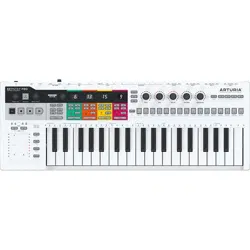Loading ...
Loading ...
Loading ...

5.2.5. Arpeggiator Features
The KeyStep Pro's arpeggiators have many features not found on other arpeggiators. To
start with, there are three arpeggiators (on Tracks 2, 3 and 4). Imagine the creative options
at your disposal when you have three arpeggiators in HOLD playing simultaneously and you
can transpose each of them individually within its predefined scale — and each arpeggio is
running in a different scale!
When HOLD is active, the arpeggiator will run indefinitely and you can focus on making
changes to the selected arpeggio.
With the exception of Pitch, all main encoders can be used to edit the arpeggio. These edits
are global for that arpeggio: you cannot change the parameters of individual notes within
the arpeggio. You can, however, make the following global edits: change the Gate time,
Velocity, Time Shift and Randomness. To hear the effect of Time Shift, you need to have two
arpeggios on HOLD running simultaneously. Randomness will apply random pitch changes
to the arpeggio.
5.2.5.1. Arp Pattern Directions
Just above the keys, from F to B in the lower octave, you'll find a series of blue Arp Pattern
labels: Up, Down, Exclu, Inclu, Rand, Order and Poly. These are used to select how the
arpeggiator will play the notes of the chord you're currently holding down on the keyboard.
To activate one of these functions, hold down the 'Shift' button and press the appropriate
key.
• 'Up' will play the notes of your chord from left to right or bottom to top, depending
on your point of view. The order in which you press the keys does not matter.
The arpeggiator will always play the individual notes from left to right.
• 'Down' plays the notes of your chord from right to left or top to bottom.
• 'Exclu' plays the chord notes in pendulum motion without repeating the bottom
and top endnotes.
• 'Inclu' plays the chord notes in a pendulum motion, including a repeat of the two
endnotes.
♪: Exclu and Inclu both play your chord notes in pendulum motion; that is, up and down, then up
and down again repeatedly. The difference is what happens at the extreme ends of the arpeggio. Let's
say you have a four-note chord. In 'Exclu' mode it will be arpeggiated as 1,2,3,4,3,2,1,2 .... In 'Inclu' your
arpeggio will be played as 1,2,3,4,4,3,2,1,1,2 ....
• 'Random' will play the notes of your chord in ever-changing random order.
• 'Order' will play the notes of your chord in the order you played them. You can
use this to good effect by repeatedly playing the same chord but changing the
order in which your fingers touch the keyboard.
• 'Poly' will repeat the entire chord as a block chord – all notes at the same time –
instead of arpeggiating its notes in series. The octave of the repeated notes will
depend on the selected Arp Octave parameter, which will transpose the whole
chord into a different octave and then return to the current octave.
66 Arturia - User Manual Keystep Pro - Making Tracks
Loading ...
Loading ...
Loading ...
